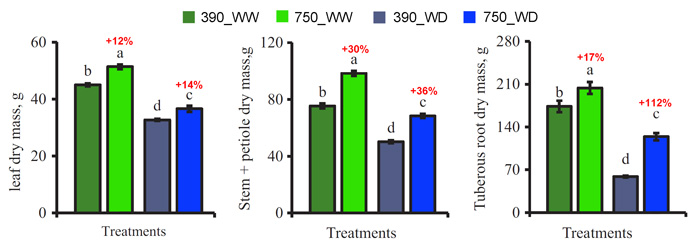| Tweet | Follow @co2science |
Paper Reviewed
Cruz, J.L., LeCain, D.R., Alves, A.A.C., Filho, M.A.C. and Coelho, E.F. 2018. Elevated CO2 reduces whole transpiration and substantially improves root production of cassava grown under water deficit. Archives of Agronomy and Soil Science 64: 1623-1634.
Writing as background for their work, Cruz et al. (2018) say that, in cassava, "the positive effect of elevated CO2 levels on the total dry mass production [has been] found to be more pronounced under water deficit conditions; likewise, the negative effect of water deficit [has been shown to be] greater on dry mass of plants grown under ambient conditions than those grown under high CO2 concentration," citing earlier work they had conducted and published two years ago (Cruz et al., 2016). However, they go on to note that their earlier work did "not address the effect of elevation of [CO2] on tuberous root production, the economical part of the plant, nor on the partitioning of cassava assimilates." Thus, in their current work, they set out to remedy this data-gathering omission.
To accomplish their work, the five scientists grew cassava (Manihot esculenta, cv CM 507-37) in a controlled-environment greenhouse setting at the USDA-ARS Crops Research Laboratory in Fort Collins, Colorado, USA. There, over a period of 100 days, the plants were grown under ambient (390 ppm) or elevated (750 ppm) CO2 concentrations and well-watered or water-deficit conditions. Regulation of CO2 occurred daily between 06:00 h and 18:00 h. Water deficit cycles were initiated 30 days after the experiment began and included suspending irrigation for half of the plants in each CO2 treatment for seven days, followed by normal daily irrigation for the next seven days. In all, five water deficit cycles were completed over the course of the experiment. Measurements of CO2 assimilation, transpiration and growth were conducted during the fourth deficit cycle and plant dry masses were obtained at the end of the fifth and final deficit cycle.
In discussing their findings, Cruz et al. report that elevated CO2 "reduced the negative effect of drought on transpiration, water use efficiency, all growth measures and harvest index." And they further report that "irrespective of the water availability, cassava presented lower transpiration as well as higher total dry matter yield (leaves + stem + tuberous roots [see Figure 1]) when cultivated under elevated CO2 concentration, as compared to ambient conditions." With respect to the latter parameter (tuberous root production) elevated CO2 increased it by a respectable 17% under well-watered conditions and a whopping 112% under water-deficit conditions, indicating that "the CO2 effect was relatively stronger to the production of tuberous roots when cassava were subjected to water-deficit."
Explaining these findings, Cruz et al. write that higher levels of CO2 help cassava plants to "partially overcome the stomatal limitations imposed on the leaves by the water deficit, resulting in greater assimilation of carbon," thus improving what they call the "transpiratory efficiency (biomass accumulation/water consumed)" of cassava. And in light of these several important findings, they conclude that their results "suggest that cassava tuber production might be resilient to changes in precipitation that will accompany higher atmospheric CO2," and "reinforce cassava as a specie that can contribute to mitigate hunger in a changing climate environment." And that is great news for a crop that consistently places in the top 10 of all crops in terms of total global food production.

Figure 1. Dry mass of leaf (A), stem + petiole (B) and tuberous root (C) of cassava plants grown under ambient (390 ppm) or elevated (750 ppm) CO2 concentrations and well-watered (WW) or water-deficit (WD) conditions. Different letters accompanying each bar indicate a significant difference between treatments (p ≤ 0.05). The percent differences in dry mass due to elevated CO2 for each water treatment are shown in red. Adapted from Cruz et al. (2018).
Reference
Cruz, J.L., Alves, A.A., LeCain, D.R., Ellis, D.D. and Morgan, J.A. 2016. Elevated CO2 concentrations alleviate the inhibitory effect of drought on physiology and growth of cassava plants. Scientia Horticulturae 210: 122-129.




